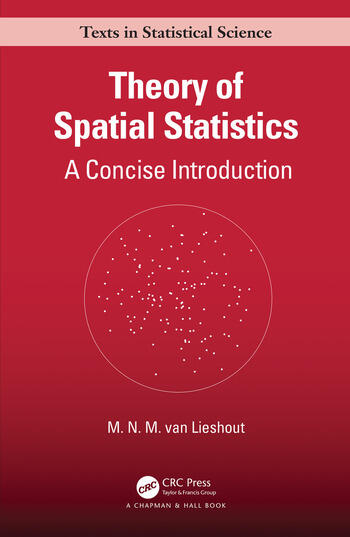
- Author: M. N. M. van Lieshout
- Series: Texts in Statistical Science
- Publisher: CRC Press
- Publication Date: 03/19/2019
- Number of Pages: 182
- Format: Hardcover
- Price: $180.00
- ISBN: 9780367146429
- Category: textbook
[Reviewed by Oleg Makhnin, on 03/14/2021]
This book does exactly what it promises. It contains a brief introduction to 3 topics in spatial statistics: continuous random fields (with kriging), models for discrete and areal data, and spatial point processes.
Compared to the comprehensive Handbook of Spatial Statistics (to which Ms. Lieshout is a contributor), the number of topics is necessarily small, but they are well chosen and feel representative of the greater field of spatial statistics. It covers such mainstays as kriging and variogram estimation, autoregressive models, Markov random fields (with the Hammersley-Clifford theorem), Potts models, Poisson, Strauss and Cox point processes. Significant attention is paid to statistical estimation methods, which include least squares, method of moments, likelihood and pseudo-likelihood inference, and Bayesian methods, including Markov Chain Monte Carlo.
Each chapter begins with an overview of the basics of theory, includes proofs of the main results, R examples of data analysis, a literature overview and exercises. Literature overview includes classical works in the field, together with a brief historical sketch. The data examples are mostly based on well-known data sets and R packages. For instance, one example for point processes is based on the Beilschmiedia trees dataset also discussed in Handbook of Spatial Statistics and the R package spatstat. Each chapter also contains 15 exercises.
The book is well-written, if a little dense. The author's approach is to handle the theory first, and give motivating applications in the end. Occasionally, this reader had to spend some time unpacking the statements presented. The book's level is stated to be for advanced mathematics undergraduates and graduate students, but the level is fairly demanding. The reader must be familiar with measure theory, mathematical statistics, stochastic processes and R statistical software. The proofs of main results are fairly detailed, for example, the proof of Bochner’s theorem takes almost three pages.
In my opinion, the book is most suitable for well-advanced mathematics students and researchers, with the aim to whet their appetite for further studies of the spatial statistics. As such, it may be suitable for a one-semester introductory course. Overall, I think the author succeeds in her goal to present an accessible and rigorous introduction to the theory and applications of selected topics in spatial statistics.
Oleg Makhnin is an associate professor of mathematics at New Mexico Tech. He works on statistical modeling of complicated data and teaches statistics, probability, stochastic processes and geostatistics.